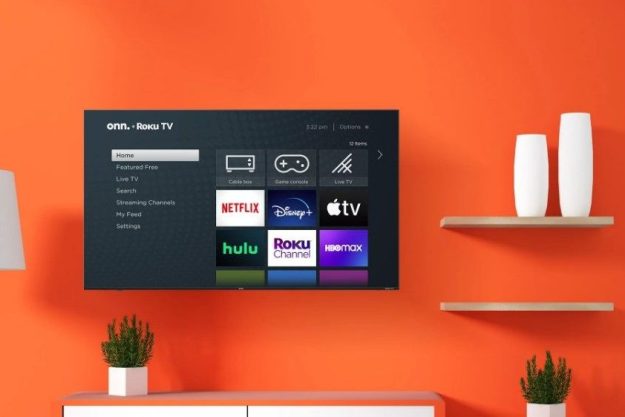“The SDI iHome iH5r alarm clock is a good first attempt at bridging the iPod-alarm clock gap.”
- iPod integration; charges iPod; good looking
- Below average sound quality; annoying alarm; limited iPod control
Summary
Just when you thought there wasn’t room for another iPod accessory, SDI drops the iHome iH5r. The first, and most closely matching, iPod-compatible alarm clock has a number of drawbacks, but makes a decent stab at conquering the bedroom with all that glossy, white, plastic glory. Before you point out that the iPod already has an alarm clock program built in, read on.
Features and Design
It seems that there is an iPod dock for every occasion. Besides the flood of iPod-specific docks with integrated speakers, like the Bose SoundDock and Klipsche iFi, you can integrate your glossy, white music machine with your car stereo, home stereo, Xbox360, etc. So, why not start your day with your favorite tunes, a la iPod? Sure, the iPod’s built-in alarm clock function works perfectly well with a set of external speakers, but there are several drawback to this. First, if you forget charge your iPod, you’ll be cursing the integrated battery on your way to the office… late. Second, you have no way to listen to the radio. And third, there’s a certain psychological attachment to that annoying, blaring piece of technology that wakes us from our sweet, sweet slumber.
The SDI iHome iH5 is a great, all-around idea for an iPod product. Integrate the iPod into an alarm clock so you can take advantage of your extensive collection of MP3s in the form of a wake-up call. Out of the box, you get the basics: The iH5 alarm clock, AM loop antenna, power cord, and dock inserts. It is not clear from the website or packaging, but there are two versions of the iHome iH5, both sold as the same model, with the second version designated the iHr. From what we could gather, the second version includes more dock inserts (including for the Nano) and the once optional remote, and changes a couple of the buttons.
The iHome iH5r feels solid, but slightly cheap. The plastic feels thin, and the glossy appearance is due to standard plastic glossing, not an additional protective coating, as with the iPod. The iPod docks on the top of the unit and stands upright. SDI also offers a black version of the iH5r through their website.
The iH5r is relatively large for an alarm clock, so expect it to take up a good portion of your night stand, since there’s no wall mount option. The primary use buttons form three rows along the top and allow for alarm setting, sleeping, radio mode, and snooze, among other standard alarm clock functions. Two large control dials appear at first glance to be iPod interface-inspired, but really just act the same as normal alarm clocks, changing volume and incremental settings like alarm time. Settings that you don’t use frequently, like Daylight Savings Time and clock time set, are controlled by buttons on the back. Also along the back are the line-in, line-out, and power port. There is a string-like FM antenna and loop AM antenna. The display has a nice blue backlight, but characters were on the small side. Suffice it to say, the iH5r is meant to be used right next to the bed.
Image Courtesy of iHome
Setup and Use
The overall functionality is similar to that of your average cryptic, modern alarm clock. There’s a lot of holding one button while pressing another, holding this button for two seconds then doing something else, etc. We could go through the operation of setting an alarm or changing a radio station, but the procedure is like any other clock (with a notable exception being the complete lack of radio memory buttons). The main difference is that in addition to setting the alarm mode to radio or buzzer, you can select the iPod. The iHome iH5r supports all iPods through the dock connector except the Gen 1 and 2. The line-in can be used to play music through the unit’s speakers, but not for the alarm clock. Because the iPod can be controlled through the dock, the iH5r can tell it to turn on and play. With an external device, you would have to have the device playing all night, which could be a big problem if the batteries run out or the playlist ends before you wake up. One advertised feature, the “Gentle Wake,” is supposed to gradually increase the volume when the alarm sounds. Instead, it ramps the volume up to max in around 5 seconds–way too short. Also, there is only one alarm, and we would like to have seen two. If the alarm is set to use the iPod, and one isn’t connected, the iH5r will sound the buzzer. There is no control over the iPod through the iH5r; the iPod has to be controlled by the scroll wheel on the iPod or the remote. The downside of the remote is that it does not control the playlists or navigation, only next/previous song, volume, and play/pause.
Sound quality of the iH5r leaves a lot to be desired. We tested a selection of electronic, rock, and jazz music on an iPod through the dock and the line-in. The built-in speakers are not powered, so portable devices need to be at over ¾ volume to make any impact in a medium-sized room. The iH5r does a decent job with mids at most volume levels. Bass at higher volumes was distorted and crackly, and highs at modest levels were slightly shrill. At lower volumes, the bass is nearly non-existent, and highs and mids were decent. The best appeared to be right in the middle–all sound characteristics were acceptably represented. Overall, the sound is sub-par compared to many other options, but isn’t that poor. For the price point and included alarm clock features, the iH5r has respectable sound. One final note on sound: You cannot change the wake up volume. If you like a loud startle in the morning, this may be the jolt you were looking for.
Conclusion
The SDI iHome iH5r alarm clock is a good first attempt at bridging the iPod-alarm clock gap. The sound quality left us slightly disappointed, but on par with several other options at the same price point. But, sound quality is generally not the selling point for an alarm clock. The functionality is straightforward, but makes some rookie mistakes we hope to see addressed in later revisions. In the end, there are a lot of small nuisances that a new owner will have to get used to, but if you must have an iPod-integrated alarm clock, this is your best (and only) option.
Pros:
- iPod integration
- Charges iPod
- Aesthetics
Editors' Recommendations
- Updating our Sony WF-1000XM5 review
- New leak hints at Sonos’ future: Bluetooth, spatial audio, and lots more home theater
- Marshall’s third-generation home speakers go eco-friendly with a wider soundstage
- Tivoli Model One Digital radio hands-on review: Small changes, big difference
- Sonos Move vs. Bose Portable Home Speaker: Smart portable shootout





